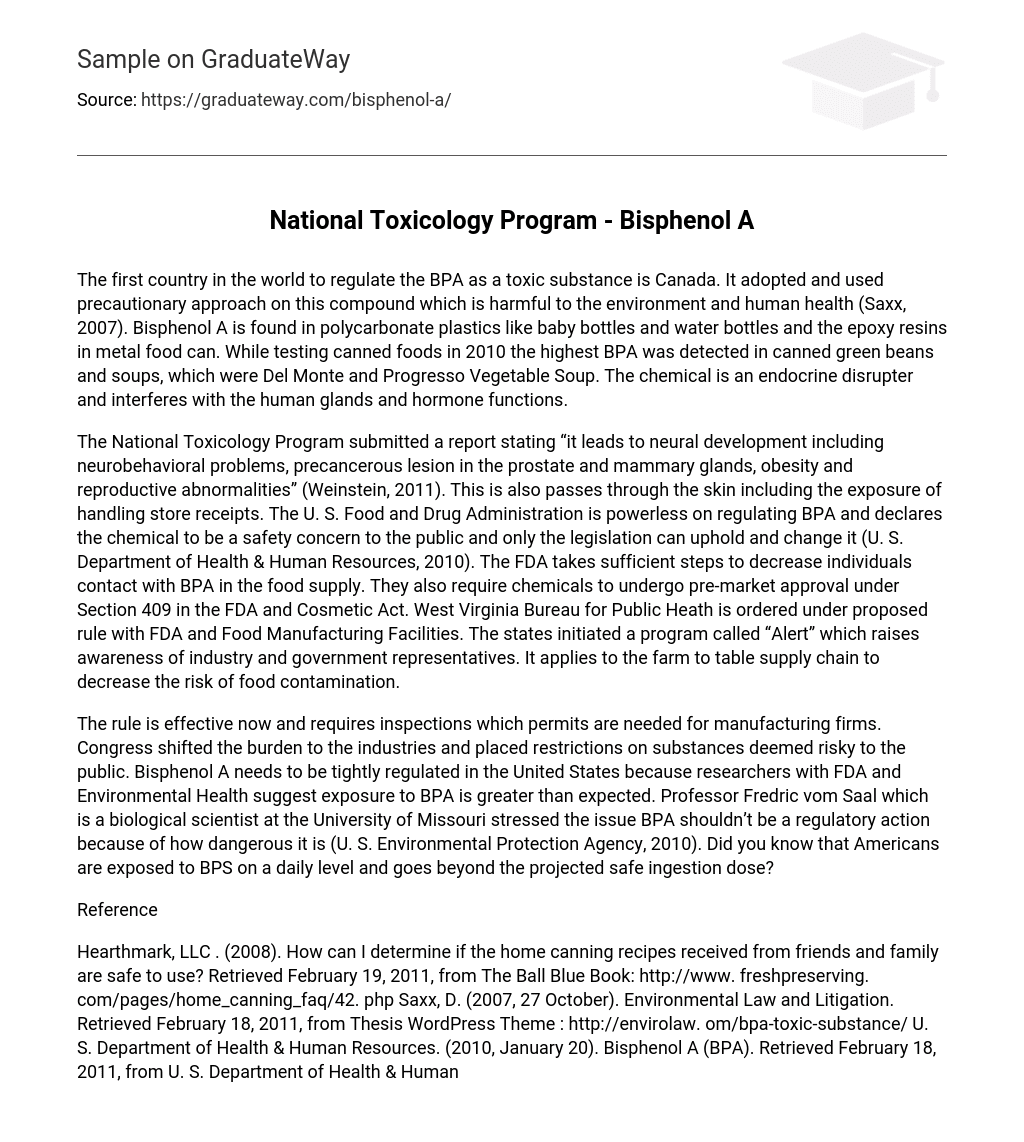The first country in the world to regulate the BPA as a toxic substance is Canada. It adopted and used precautionary approach on this compound which is harmful to the environment and human health (Saxx, 2007). Bisphenol A is found in polycarbonate plastics like baby bottles and water bottles and the epoxy resins in metal food can. While testing canned foods in 2010 the highest BPA was detected in canned green beans and soups, which were Del Monte and Progresso Vegetable Soup. The chemical is an endocrine disrupter and interferes with the human glands and hormone functions.
The National Toxicology Program submitted a report stating “it leads to neural development including neurobehavioral problems, precancerous lesion in the prostate and mammary glands, obesity and reproductive abnormalities” (Weinstein, 2011). This is also passes through the skin including the exposure of handling store receipts. The U. S. Food and Drug Administration is powerless on regulating BPA and declares the chemical to be a safety concern to the public and only the legislation can uphold and change it (U. S. Department of Health & Human Resources, 2010). The FDA takes sufficient steps to decrease individuals contact with BPA in the food supply. They also require chemicals to undergo pre-market approval under Section 409 in the FDA and Cosmetic Act. West Virginia Bureau for Public Heath is ordered under proposed rule with FDA and Food Manufacturing Facilities. The states initiated a program called “Alert” which raises awareness of industry and government representatives. It applies to the farm to table supply chain to decrease the risk of food contamination.
The rule is effective now and requires inspections which permits are needed for manufacturing firms. Congress shifted the burden to the industries and placed restrictions on substances deemed risky to the public. Bisphenol A needs to be tightly regulated in the United States because researchers with FDA and Environmental Health suggest exposure to BPA is greater than expected. Professor Fredric vom Saal which is a biological scientist at the University of Missouri stressed the issue BPA shouldn’t be a regulatory action because of how dangerous it is (U. S. Environmental Protection Agency, 2010). Did you know that Americans are exposed to BPS on a daily level and goes beyond the projected safe ingestion dose?
Reference
Hearthmark, LLC . (2008). How can I determine if the home canning recipes received from friends and family are safe to use? Retrieved February 19, 2011, from The Ball Blue Book: http://www. freshpreserving. com/pages/home_canning_faq/42. php Saxx, D. (2007, 27 October). Environmental Law and Litigation. Retrieved February 18, 2011, from Thesis WordPress Theme : http://envirolaw. om/bpa-toxic-substance/ U. S. Department of Health & Human Resources. (2010, January 20). Bisphenol A (BPA). Retrieved February 18, 2011, from U. S. Department of Health & Human Resources: http://www. fda. gov/newsevents/publichealthfocus/ucm064437. htm US Environmental Protection Agency awards task order to CGI Federal. (2010). Telecomworldwire (M2), Retrieved from EBSCOhost. Weinstein, H. (2011). Canned Chemicals: With Worries About BPA on the Rise, Food 22(1), 40. Retrieved from EBSCOhost.





